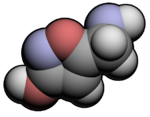Muscimol
Muscimol is a potent and selective orthosteric agonist for the GABAA receptor[3] and displays sedative-hypnotic, depressant and hallucinogenic[citation needed] psychoactivity.
Its high affinity and specificity for GABA-A receptors allow researchers to study synaptic transmission, neural circuit dynamics, and the overall role of GABAergic inhibition in various physiological and pathological states.
[10] GABAA receptors are widely distributed in the brain, and so when muscimol is administered, it alters neuronal activity in multiple regions including the cerebral cortex, hippocampus, and cerebellum.
[15] When consumed, a substantial percentage of muscimol goes un-metabolized and thus excreted in urine, a phenomenon exploited by Siberian practitioners of the traditional entheogenic use of Amanita muscaria.
[16] In patients with Huntington's disease and chronic schizophrenia, oral doses of muscimol have been found to cause a rise of both prolactin and growth hormone.
[18] Muscimol primarily functions as a GABA-A receptor agonist, mimicking the action of GABA, the main inhibitory neurotransmitter, in the central nervous system.
[4] A handful of exploratory clinical trials (n≤10) probing the utility of muscimol in the treatment of schizophrenia, Huntington's disease, and tardive dyskinesia occurred between 1977-1982.
[32][33] Muscimol, a psychoactive compound derived from the ibotenic acid found in certain mushrooms, particularly Amanita muscaria, has garnered significant interest due to its unique effects on the nervous system.
[36] However, ongoing research aims to harness its medicinal benefits in a controlled context, highlighting the broader scientific interest in natural compounds as potential sources for novel medical treatments.
[44] In instances where pure muscimol is not required, such as recreational or spiritual use, a crude extract is often prepared by simmering dried Amanita muscaria in water for thirty minutes.
(2) was then refluxed in concentrated hydrochloric acid to hydrolyze the methoxy group, and the zwitterion crystallized from a solution of methanol and tetrahydrofuran after the addition of triethylamine, resulting in a 50% yield.
It begins with the combination of 2,3-Dichloro-1-propene (6), potassium bicarbonate, water, and dibromoformaldoxime (7) (which is a well known precursor of bromo nitriloxyde, a reactive dipole for regioselective Diels-Alder cycloadditions, which forms in alkali), all dissolved in ethyl acetate.
[51] Muscimol has shown potential as an anticonvulsant, blocking seizures induced by various agents in animal models without causing significant toxicity at therapeutic doses.
[52] Studies on muscimol's distribution in rats showed it enters the brain and is metabolized rapidly, suggesting that its toxicity is low when used in controlled doses.
[53] Its toxicity appears to be low when used in controlled environments, with no long-term damage observed in animal studies and human cases resolving without severe outcomes.
Except as a constituent of lawfully manufactured food or dietary supplements, the act outlaws preparations of the Amanita muscaria intended for human consumption, including muscimol.









